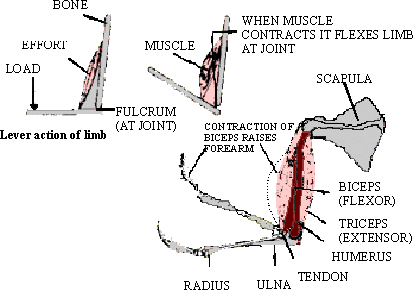There are almost 700 skeletal muscles of the human
body, governed by a few basic principles involving muscle movements
or muscular activity.
(i) Skeletal muscles produce movements by
pulling on bones or tendons. The tendon gives a very firm anchorage.
The point where a muscle is connected to an immovable or
relatively fixed bone is called the point of insertion.
It is nearer to the central portion of the body. The movable bone
is connected by a tendon at the point of insertion and is away from
the central portion of the body.
(ii) The bones serve as levers and
joints act as fulcrums for the levers; Figure 21.6 makes
this clear. Muscles can only contract a short distance, but since
they are attached near a joint, the movement at the opposite end
of a limb is greatly magnified. The biceps muscle of the arm may
contract only 89 to 90 mm, but the hand will move about 60 cm.
(iii) The muscles that move a part of the
body usually do not lie over that part. For example, the biceps
muscle that moves the lower arm does not lie over the lower arm
(it is attached to it by tendons). But lies in the upper arm (Fig.
21.6). Similarly, flexors of the wrist are located in the lower
arm and not in the wrist.
(iv) The skeletal or voluntary
muscles act in pairs rather than singly. One of the muscles
produces contraction while the other allows relaxation.
Flexion results when contraction causes two bones to bend
toward one another, while extention results from contraction
of antagonistic muscles, resulting in an increase in angle between
two bones. Such pairs of muscles are called antagonistic.
Often antagonistic muscles are in groups, e.g., both the brachialis
and the biceps muscles flex the arm at the elbow and antagonize
the triceps, but only when the palm is facing upwards. Of such pairs
or groups of antagonistic muscle, one is usually much stronger than
the other. The biceps, which flex the arm are larger and more powerful
than the triceps which extends it. The gastrocnemius and
soleus muscles of the calf which extend the foot at the ankle
are stronger than the peroneus muscles which flex it.
(v) When the body is at rest, the
proportion of antagonistic skeletal muscles remain in a state of
contraction, called muscle tone, which holds the body in
rigid position. If the person becomes unconscious, or is
asleep, muscle tone is lost as the muscles relax completely.
(vi) For every action there is an opposing
or restoring action (antagonists muscles). Rarely does one muscle
contract alone, but is assisted by another . Synergists are
muscles that supplement or assist one another, thereby reducing
undesired action or unnecessary movement.
(B)Involuntary muscles. The involuntary
or smooth muscles occur in the (intestines, gall bladder,
urinary bladder ureter), arteries, iris, diaphragm of the eye etc..
They are abundant in sluggish invertebrates like molluscs. Structurally
they are different from voluntary or skeletal muscles. They are
usually under automatic rather than voluntary control. In the alimentary
canal etc. their distribution in circular and longitudinal muscles,
allows an antagonistic action.
Involuntary muscle produces relatively slow
but prolonged contractions, or rhythmic contractions
as in peristalsis.

Figure 21.6 Antagonistic muscles of the forearm
(C) Criteria for naming muscles
Muscles are often given names that describe their
actions (levator, flexors, adductor extensors, abductors,
depressors, sphincters, supinators, pronators.).
(ii) By shapes (biceps, delltoid rhomboideus,
trapezius).
(iii) By positions (temporalis, pectoralis,
gluteus, rectus femoris, tibialis anterior).
(iv) By attachments, the origin being named
before the insertion (geniohyoid, sternomastoid stylohyoideus.)
While most muscles were first named in the human, the terms are
not always appropriate when applied to homologs in other animals.
|
SUMMARY
(1) Movement of the entire organism, or locomotion,
has evolved primarily in response to predator-prey interactions,
and many other activities which help in the survival of the
organism. (2) Skeletal muscles are involved in locomotion,
and are attached to two or more bones in vertebrates and to
two or more external rigid plates is most invertebrates. (3)
Most muscles occur in antagonistic pairs, one producing flexion
while other extention . Skeletal muscles are voluntary muscles.
(4) Joints between the bones are of three types. (a) Fibrous
or Immovable joints. (b) Cartilaginous or slightly movable
joints. (c) Sinovial or movable joints on the basis of variations.
Each type is subdivided into different types.
|
